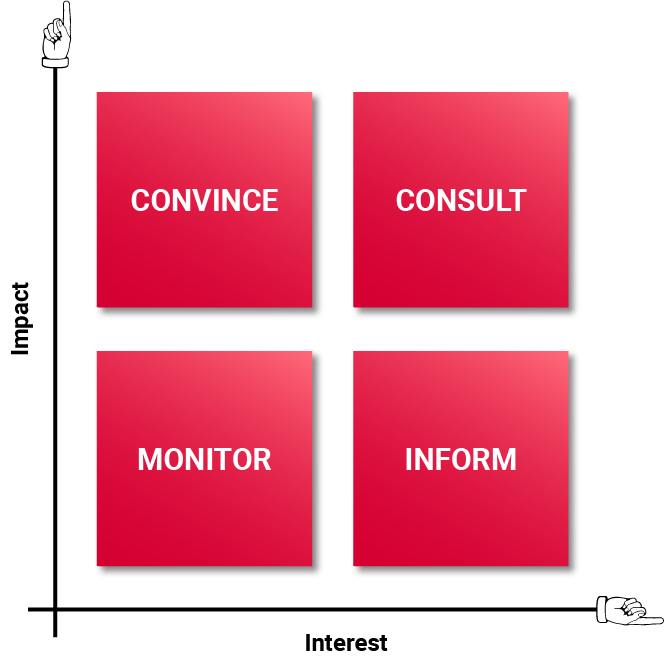Change Management Initiation: Building a Strong Change Imperative & Readiness
What is Change Initiation?
Change Initiation is the first step in effective Change Management, and the process of preparing your organisation for change.
Arguably, the Change Initiation process is the most critical component of any change activity, as it requires a blend of strategic vision, effective communication, and a commitment to inclusivity across the stakeholder landscape.
We provide guidance to our clients throughout the Change Initiation activity, supporting:
- Change Imperative Creation and Communication
- Change Impact and Legacy Evaluations
- Stakeholder Mapping
- Adapter & Organisation Readiness Evaluation
Failure to undertake a comprehensive Change Initiation activity can result in the creation of obstacles to the success of your project, many of which could be irreversible. If you lack the in-house experience or this is your first major business transformation project, we highly recommend you seek external guidance—particularly in the planning stages.
The Change Imperative
The Change Imperative is our Why, the business rationale driving the change activity. The identification and communication of our Why is clearly an important activity, but it is remarkable how frequently teams who are tasked with change implementation are oblivious to these drivers, even if their jobs depend on it.
The impact of failing to effectively communicate the Change Imperative is disengagement. Rather than creating a sense of ownership and urgency, the Change becomes another disjointed request from senior management that fails to ignite Change Agents into action. The unfortunate result is often a superficial implementation of the change, and a failure to ingrain the initiative into the operational fabric of the business.
The Change Imperative narrative should be a well-crafted and concise elevator pitch of the proposed change, designed with the intent to engage stakeholders in the creation of the desired future state of the business.
The Change Imperative should also form the basis of the communication strategy throughout the project. A consistent change message helps increase employee engagement, foster collaboration, and develop a collective commitment to the journey ahead.
At Cambridge MC, we leverage a suite of diagnostic and communication tools to support the codification of the Change Imperative into a compelling narrative, comprising the following components:
- Why – Organisation imperative driving the change
- What – A Vision of the Desired Future State
- How – Creating Visibility of the Solution
Change Impact Evaluation
A Change Impact Evaluation helps define the scope of the change activity and the adaptation that needs to be implemented across the organisation value chain. The evaluation involves an assessment of how alterations to processes, systems, or structures will affect employees, workflows, and overall performance.
During this evaluation, subject matter experts should analyse different sections of the business to identify potential risks and benefits associated with the change initiative.
In most environments, we assess impact in terms of the following criteria:
- Scope
- Governance
- Resources
- Infrastructure
- Culture
- Enabling Mechanisms (Technology)
This evaluation helps serve as a compass for leadership, providing valuable insight into the scope of the change being undertaken, paving the way for tailored strategies to mitigate stakeholder resistance, smoothing the change activity, and minimising operational disruptions.
Change Legacy Evaluation
To help secure employee engagement, we suggest using a Change Legacy Evaluation. This activity gives stakeholders an opportunity to voice their concerns by reviewing previous change activities, providing insight into what worked and what didn’t.
‘Lessons learned’ activities of this nature provide valuable insight into opportunities for improvement, but also support employee engagement objectives. Through active engagement on legacy issues, you will position leadership as agents of positive change and gain a better understanding of how to improve the delivery of future change initiatives.
There are 6 Legacy Evaluation Categories to consider:
Shared Change Purpose – Did the team understand what was driving change?
Leadership Support – Were the leadership team effective?
Sponsor Engagement – Was senior management actively engaged?
Team Engagement – Was the team included in the change activity as contributors?
Personal Impacts – Was the change a positive experience for staff?
Practicality – What improved?
Stakeholder Mapping
Stakeholder mapping is another often overlooked activity, but something we believe is critical for successful project delivery. Complex transformations are tricky enough—forgetting to engage key stakeholders who hold the keys to your success is not a good move. The importance of stakeholder mapping lies in its ability to systematically identify and analyse those who are affected by or can influence a project, be that positively or negatively.
Effective stakeholder mapping facilitates informed decision-making, enabling a more targeted allocation of resources and efforts. It also aids in identifying potential risks and opportunities associated with various stakeholders.
The output of this mapping activity should help clarify dependencies across the value chain, and represents a key input to the planning and execution phases of the change initiative.
We help our clients better understand stakeholders' interests, expectations, and levels of influence, so they can tailor communication strategies, mitigate potential conflicts, and garner support.
Stakeholders should be categorised in terms of their
INTEREST and
IMPACT on the project. Engagement and communication strategies should subsequently be aligned to the stakeholder’s role within the organisation and their contribution to the project:

INFORM
Stakeholders with a significant interest in the success of the project but limited ability to positively impact the project. These stakeholders should be updated and their interest maintained.
CONVINCE
Stakeholders' moderate commitment belies their crucial role in project success, given their significant impact and influence. Communication strategy and messaging should be such that it enforces project success and positive impact on the broader organisation.
CONSULT
Key stakeholders who wield substantial influence on project success and the organisation. These stakeholders should be managed closely and actively engaged in project delivery.
MONITOR
Stakeholders should be kept informed, but balance communication efforts to avoid excessive time and resource allocation for updates.
By identifying stakeholders in terms of their impact and interest, we can create an intentional communication and engagement strategy that aligns to specific project interests and individual targets. When people feel engaged and that their opinions are appreciated, they are far less likely to become a barrier to the project.
Adapter Readiness
Our goal for all projects is the smooth adoption of change through the transformation process. Before we start changing things, we always assess both adapter and organisation readiness to support the proposed change activity. This is critical in preventing future roadblocks and internal resistance to change.
To sustainably embed change in the organisation, we need employees to understand, accept, and own the change process.
To be successful, adapters must possess the necessary skills, knowledge, and flexibility to adapt to new processes, technologies, or structures. To achieve this flexibility in your transformation goals, we recommend the development of training, recognition, rewards and measures with a goal of moving adapters through the following stages:
- Awareness – 'I get it'
- Acceptance – 'I buy it'
- Commitment – 'I own it'
Once employees own the change, the effort required to ingrain the change within the organisation is greatly reduced, accelerating implementation and achieving ROI goals in a more timely manner.
Organisational Change Readiness
Organisational readiness involves evaluating the overall preparedness of the entire workforce and system landscape for the impending change. It involves ensuring that employees at all levels understand the reasons behind the change, have the required competencies, and are receptive to the proposed modifications.
Typical areas for organisation readiness should include:
- Leadership
- Strategy
- Governance
- IT systems
- Processes
- Technologies and
- Culture
Once an organisational readiness evaluation has been completed, we recommend the development of end-to-end user journeys across the impacted areas, identifying training and transformation requirements.
By comprehensively assessing both adapter and organisational readiness, organisations enhance their ability to implement change effectively and mitigate potential resistance or disruptions.
Collaborating with Cambridge MC and implementing our Change Management methodologies guarantees your business the ability to thrive during the transformative process.
We can be your change management partner, providing an enhanced process that lowers risk and increases the expected benefits.
Stay tuned for the next phase of our Change Management path – Planning
Contact us now to find out how our Change Management methodology can act as the critical enabling mechanism to support your project’s success.
About Cambridge Management Consulting
Cambridge Management Consulting (Cambridge MC) is an international consulting firm that helps companies of all sizes have a better impact on the world. Founded in Cambridge, UK, initially to help the start-up community, Cambridge MC has grown to over 150 consultants working on projects in 20 countries.
Our capabilities focus on supporting the private and public sector with their people, process and digital technology challenges.
For more information visit
www.cambridgemc.com or get in touch below.
Contact - Africa
Subscribe to our Newsletter
Blog Subscribe
SHARE CONTENT











